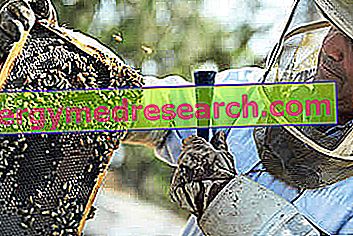In collaboration with Dr. Eleonora Roncarati
(2) De-capping
Uncapping is the first phase of the actual processing. It consists in eliminating the layer of wax that closes the cells containing the honey. It is carried out with the help of knives, which can also be heated to facilitate the operation, or with semi or completely automatic de-capping machines, equipped with blades or chains that cut or crush the wax.

ChameleonsEye / Shutterstock.com
Automatic de-capping machines, used mainly by those who have a high number of hives, have the disadvantage of crumbling the wax much more than the other "shear" systems; they must be followed by particularly accurate product purification systems. However, the finest wax particles produced by this type of de-capping can still be incorporated into the honey and cause a slight turbidity and a more rapid crystallization, characteristics that will be considered a defect in the honeys to be marketed in liquid state.(3) Demining or extraction
Once the cells have been uncoupled, the extraction of the honey takes place through the use of honey extractors which, thanks to the centrifugal force, make the honey escape and allow the combs to be reused. In centrifugal extractors, of different sizes according to the type of activity, manual or automatic, the combs are loaded one by one or by means of special baskets or in the same tops. With these devices the honey is let out by centrifugal force and the combs remain available for the next harvest. The honey can be extracted completely only if it is sufficiently fluid and this normally happens if its temperature is close to 30 °. Also the honey extractors and the other equipment with which the honey comes into contact in these first stages of processing (bench for uncoupling, knives, grills, containers) must be made of material suitable for contact with this food.
(4) Decantation and Filtration
The decantation leads to the separation by difference in specific gravity of the impurities that rise to the surface if read (wax, insects and parts of insects, organic materials of various nature, air bubbles) or that are deposited on the bottom if heavy (mineral particles and metallic) from where they can easily be eliminated. The process takes place by leaving the honey to rest in special containers (usually and improperly called "ripeners") for a time ranging from a few days to a couple of weeks. The settling speed varies according to the type of impurity (smaller, slower migration), the size of the settling vessel and the viscosity of the honey, which in turn depends on its water content and temperature.
At temperatures of 25 - 30 ° C the decantation occurs relatively quickly (from a few days to a couple of weeks) in most cases.
The decantation can become problematic in the case of particularly viscous honeys (with a low water content) or when the temperature is lowered or for fast crystallization honeys: in these cases it is necessary to resort to a slight warming of the decantation environment, so that the temperature of the honey remains close to 30 ° C. The decantation can be accelerated by particular devices (settling tanks) in which the honey is heated to higher temperatures and forced to follow a path during which the impurities are progressively retained; it has the advantage of also eliminating foam and air bubbles and, if production is collected in large containers, to uniform the characteristics; the main disadvantage consists in the cost of the suitable containers and in the immobilization of the product. Contrary to what is commonly thought, the stop in the ripener does not allow to generally obtain improvements in the moisture content. On the surface of the honey an exchange of humidity is produced with the environment, but in order for this to be in favor of the product, and not to its detriment, it is necessary that the relative humidity of the air is less than 60%, something that occurs rather rarely in our climates, in unheated or artificially conditioned environments. The filtration allows to purify the honey without immobilizing it, using filters of various types as long as the pores have a diameter of less than 0.1-0.2 mm, a dimension that allows to hold (inside the honey) the grains of pollen which, according to the legislation European, cannot be removed as they allow to trace the origin of the honey. Filtration is used as an alternative or in addition to decanting (making it more rapid) but it is also the system most used to purify honey in processing plants, where the immobilization of the product connected with decantation is unthinkable. The filtration units consist of simple "bag filters" in nylon mesh or similar devices in wire mesh. The common feature consists in having a large filtration surface and being able to be used in immersion, to avoid incorporating air and so that the impurities, remaining in suspension inside the bag, will clog the pores in a very long time longer. The most common have pores with a diameter of 0.1 - 0.2 mm. For this type of filtration it is necessary that the temperature of the honey is around 30 ° C. Filtration on devices with smaller porosity, in addition to requiring more energetic conditions (higher temperatures or pressure), is prohibited by European legislation, as it would also retain the pollen grains which are instead considered part of the honey itself and would make it impossible to trace the geographical and botanical origin of honey through microscopic analysis. The normal filtration with bag filter does not allow to eliminate air bubbles (which must in any case be eliminated by decantation), nor the small mineral impurities ("black dots") which are attributable to hygienic deficiencies in the early stages of processing (superscale placed on the ground, dirty and dusty materials etc.) and that have a diameter smaller than the porosity of the filter. Speaking of honey cleaning it can be added that, in addition to a suitable system of elimination of "intrinsic" impurities (wax and air), the beekeeper must above all take care not to introduce others with inappropriate or clumsy operations.
Filtration and decantation can (and often are) be used in succession.
(5) Heating
For many of the techniques described below, it is necessary to heat the product, aimed at reducing the viscosity, melting the crystals, concentrating the product, stabilizing it microbiologically or physically.
NOTE : In any case, the heat, however applied, has a negative effect on the honey, in terms of loss of thermolabile substances, proportional to the temperature reached by the product and time. The basic concept is therefore to limit the use of heat treatments to the lowest temperature and the shortest time compatible with the technical objective to be achieved.
The peculiarity of honey in fact lies in the fact that it owes its characteristics to the nectar of flowers which, thanks to the activity of bees, is made available for human consumption. Its value consists therefore not so much in its main composition, which is similar to that of other cheaper processed sugary products (different sugars, molasses, jams), but in minor components, deriving directly from flowers and bees, which give it characteristics (aroma, taste and, probably, biological properties) different, and that are unfortunately, thermolabile and unstable over time. All this is the basis of the legal definition and use of honey in Europe, which tends to distinguish and protect honey from other sugary foods, but in the same it prescribes its use in a state in which the peculiar characteristics are preserved at best ("fresh" honey). This premise is essential to understand the principles that govern the processes of preparation of honey for human consumption, otherwise certain precautions (relating to heating and storage) that are suggested would seem to be unnecessary complications. The heating of honey, in light of the above, must be carried out with certain precautions.
Furthermore, its reduced thermal conductivity opposes uniform heating and the use of heat sources at high temperatures (flame or boiling water bath) always causes an important alteration of its characteristics. In modern systems, to heat the honey necessary to reduce the viscosity and thus facilitate the operations that require the product to flow (decantation, filtration, pumping, mixing, potting) and to melt the crystals, systems are used in which the source heat is only a few degrees higher than the temperature at which you want to bring honey. For the heating and melting of honey contained in containers for wholesale, hot-air or bain-marie chambers are used, thermostated at temperatures between 35 and 50 ° C. The melting can be completed in large containers equipped with a system heating (interspace or coil with hot water circulation) and one for mixing (propeller mixer or recirculation pump) to facilitate heat exchange.



